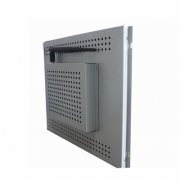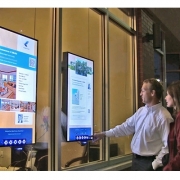How does digital signage work?
You see screens everywhere these days. In all kinds of public spaces, from shopping centers to corporate hubs, there are digital signage displays showing information that people find interesting and useful. They could be static digital signs, they could be interactive touchscreens, or there could be a big video wall. Or there could be a combination of all of these.
At its most basic level, digital signage is a screen of some sort (probably an LCD screen), some kind of visual messaging presented in a digital format, and a way for the screen to show the messages.
The basics
Technically speaking, if someone wanted to put a few PowerPoint slides on a thumb drive and play them in rotation on a flatscreen TV, that is digital signage. That’s about as basic as it can get. But the digital signage industry, which gets bigger every year, is clearly offering more than just that.

How do digital signage systems work? Here are the basic things you need:
Content — a way to design and create messages, as well as how the overall screen layout will look; could be special software programs or the design tools from another program (like PowerPoint); this can also include data feeds and subscriptions.
Management — a content management system (CMS) that organizes, schedules and delivers your messages to media players or playback devices; this software can be housed on a native content server on site or cloud based.
Playback — a media player is a PC or appliance that pushes the content to the display; the player software handles visual rendering of the messages and feeds in a content playlist, and distributes it to one or more screens.
Display — screens of some sort (usually flatscreen TVs, LCDs) that are wall-mounted or contained within a kiosk; could be interactive touchscreens for things like wayfinding and menu boards; can also be several screens networked into a video wall.
Infrastructure — this is all of the mounts, cabling, network connections, etc. that enable the messages to go from the content server to the media players to the displays; could include internet connection to show live web pages, social media feeds, real time data feeds and more.
Most companies who offer high brightness digital signage software cover the first three items on the list. Usually, an audiovisual integrator or IT reseller can help with the screens and infrastructure, as well as identifying the best software solution for your environment. Although some software vendors don’t provide the playback hardware themselves (frequent with cheaper cloud-based systems), you’ll still need to have some sort of media player to get content to your screens.
When companies talk about enterprise digital signage solutions, they usually offer all five components (either in-house or through AV/IT partnerships), as well as professional services and support. Oftentimes, these digital signage providers will offer content feeds, design services, training and consulting for content and engagements strategies.
At its most basic level, a digital signage network needs:
a way to make messages.
a way to organize and schedule those messages.
something to push those messages to displays.
the displays and other hardware needed to get your messages in front of your audience.
Click here to learn more about digital signage.












